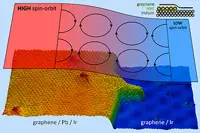Electronics News
Archive : 15 December 2014 год
 Researchers from IMDEA Nanoscience, the Autonomous University of Madrid, the Madrid Institute of Materials Science (CSIC) and the University of the Basque Country have used lead atoms and graphene to create a powerful magnetic field. The team believes this could have application in spintronics.
Researchers from IMDEA Nanoscience, the Autonomous University of Madrid, the Madrid Institute of Materials Science (CSIC) and the University of the Basque Country have used lead atoms and graphene to create a powerful magnetic field. The team believes this could have application in spintronics.
The scientists laid a layer of lead on another of graphene, in turn grown over an iridium crystal. In this configuration, the lead forms 'islands' beneath the graphene, with the electrons of this 2D material behaving as if they were in the presence of an 80T magnetic field.
"This spin-orbit interaction is a million times more intense than that inherent to graphene, which is why we obtain revolutions that could have important uses, for example in data storage," explains Rodolfo Miranda, director of IMDEA Nanoscience and head of the study.
The first generation of spintronic devices used the effect which magnetic materials have on electron spin. But, in a second generation, an electron's spin-orbit interaction acts as if there were a real external magnetic field, even if there is not.
"Under these conditions, certain electronic states are topologically protected; in other words, they are immune to defects, impurities or geometric disturbances," Miranda added. "If we compare it to traffic, in a traditional spintronic material, cars circulate along a single lane road, which make collisions more likely. With this new material, we have traffic control, with two spatially separate lanes."
Author
Graham Pitcher
Source: www.newelectronics.co.uk
 Despite economic growth running at 3% the UK electronic components market remains tough. The core industrial markets, where the majority of purchasers of electronics components in the UK operate, started to show signs of recovery in the second quarter of 2014, only for that recovery to be overshadowed by weakness in Europe.
Despite economic growth running at 3% the UK electronic components market remains tough. The core industrial markets, where the majority of purchasers of electronics components in the UK operate, started to show signs of recovery in the second quarter of 2014, only for that recovery to be overshadowed by weakness in Europe.
"The past twelve months can best be described as patchy," suggests Adam Fletcher, chairman of the Electronic Components Supply Network, "and the UK is not immune to current weaknesses in the Euro area and to instability in global markets. Despite these headwinds, we are seeing significant variations in the performance of distributors."
Fletcher highlights the success of local or specialist distributors focused on vertical markets, many of whom have experienced a significant increase in design activity.
L2Tek, a specialist distributor of electronics components and technology for communications and imaging markets, has seen demand for its high speed interface products surge as the market moves towards quicker and more reliable data transmission.
"Increasing data rates are required by customers seeking ultra high definition television (4K) transport solutions, with broadcasters now needing to move UHDT video along at 12Gbyte/s rather than 3Gbyte/s. There has also been increasing interest in embedded modules to deliver greater connectivity for cloud based and M2M solutions," explains Tim McBride, director at L2Tek.
"We work closely with our customers and suppliers to provide expert and cost effective technical support, enabling rapid product development – something that broadline distributors struggle to provide," he adds.
David Zelkha, managing director at Luso Electronics, agrees. "Rather than select traditional broadline distributors to buy components, local manufacturers serving niche markets are increasingly choosing smaller distributors to do business with. We can deliver a range of value-added services that can closely integrate into its operations, while offering easier inventory management and procurement."
Despite tough market conditions, independent components distributor Anglia Components is outperforming the market, according to managing director, Steve Rawlins.
"Innovation and our strategy of maintaining comparatively high levels of stock is central to our relationships with our customers, and allows us to remain master of our own destiny, even in unfavourable market conditions," he suggests.
"As a privately owned business we're driven by our customers rather than shareholders. We have the flexibility to buy off the back of market conditions and maintain our stock levels even in periods of comparatively low demand. Our stock is held in the UK allowing us to continue to support customers promptly when they see demand in their businesses."
According to Rawlins, "With demand weak there are high levels of inventory in the supply chain. I think the current choppy market conditions will continue into the first half of 2015 and it is a brave man who calls the market for the second half of next year, though it is likely that we will see weak growth for 2015 as a whole."
According to Rawlins the same market conditions can be seen in many of its customers' end markets and they are finding it difficult to forecast their own long term demand.
"Smart customers are aware of the fact that there is overcapacity in the market. They know that the supply chain has inventory available on relatively short lead-times and are buying to short windows and shopping around to help compensate for their own lack of forward visibility," he explains.
That trend is placing an increased transactional burden on distributors who have to take on a disproportionate amount of risk when it comes to managing inventory and there are growing calls for a more balanced and transparent relationship between suppliers, distributors and end customers.
Author
Neil Tyler
Source: www.newelectronics.co.uk
 FPGAs are becoming an increasingly important tool in the electronics designer's armoury. But while the devices are being applied in a wide range of markets, there is a suspicion that FPGA skills across UK industry may not be matched to the application needs.
FPGAs are becoming an increasingly important tool in the electronics designer's armoury. But while the devices are being applied in a wide range of markets, there is a suspicion that FPGA skills across UK industry may not be matched to the application needs.
In order to find out more about how FPGAs are used, as well as the associated challenges, industry association nmi undertook a detailed survey in October to find out what's happening in the UK and Ireland.
The survey was part of the work being undertaken by FPGA industry veteran Doug Amos, manager of nmi's FPGA Peer Network. The data will be used to expand the Peer Network's activities and to focus its support work.
Questions asked of respondents ranged from how important FPGAs are to their work and which end markets designs were targeted at to whether projects ran to time and future challenges.
It was no surprise to discover that FPGAs are being targeted at a wide range of end markets. Most popular amongst respondents was industrial (35%), followed closely by aerospace and defence (31%). However, wired and wireless communications combined to represent 37% of the market.
But when asked how important FPGAs were to these designs, the survey brought an interesting response. More than 80% of respondents claimed FPGAs were 'essential' to their work. At the other end of the scale, a couple of respondents asserted they would rather not have to use them. In between the extremes, 14% said FPGAs were 'helpful' and 4% said they were 'nice to have'.
Amos said: "The extent to which programmable logic is used in today's products is not surprising in itself. However, the degree to which the success of those products relies on FPGA capabilities is quite remarkable."
With FPGAs being 'essential', an obvious follow up question is the degree to which designers are familiar with the technology. It turned out that 27% of respondents described themselves as 'expert'. Another 46% said their knowledge was 'good'. However, 27% of respondents said their knowledge was no better than fair. This compares with a survey conducted by New Electronics in September 2012 in which 39% of respondents believed their FPGA design knowledge to be 'good', but 62% said their knowledge was no better than 'fair'.
Asked to list the main challenges they faced when implementing FPGAs, respondents put timing analysis and closure (53%) at the top of their list, followed closely by RTL verification (50%) and initial design specification (37%).
The nmi survey also asked whether extra FPGA resource was needed for the company's most significant recent project. Half of those responding said none, claiming the existing design team managed to keep its skills up to date. However, 22% of respondents said their employer made time to train staff, while 19% added extra staff in anticipation and 10% of respondents called in consultants.
And how well did the design teams manage to meet their deadlines? Almost half of those responding (44%) said they were 'slightly over schedule', with another 12% admitted to being 'well over'.
But 28% said they were 'on time' and 4% claimed to have delivered their project 'early'. In terms of project length, 62% of respondents said a typical FPGA design project was less than one engineer-year in duration.
"Anecdotally," said Amos, "many users – but not all – told us that finding new staff with the necessary level of design skills was problematic. Is this an emerging skills gap?"
NMI is expanding its FPGA Peer Network activities, looking to address what it sees as the continuing challenges in FPGA design. "Having previously noted how 'essential' FPGA is to product success," Amos continued, "it may be that nmi has a role in brokering increased knowledge sharing."
In particular, the Network will lean on the expertise of The Frontrunners Forum, which will comprise experienced FPGA users from nmi member companies. "We will meet regularly to explain to and learn from the others," Amos said, "building a core body of knowledge to help drive the FPGA Peer Network. We expect to recognise common challenges and design trends, which we will partner with key players in the FPGA ecosystem in order to guide provision of regional support, training and user development."
Author
Graham Pitcher
Source: www.newelectronics.co.uk

